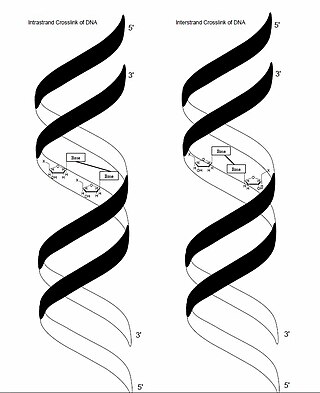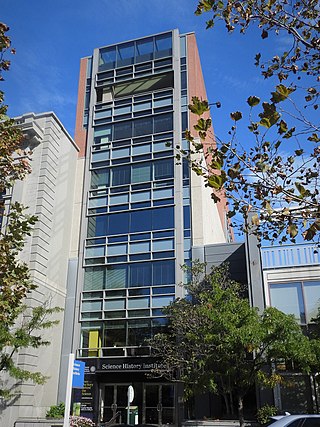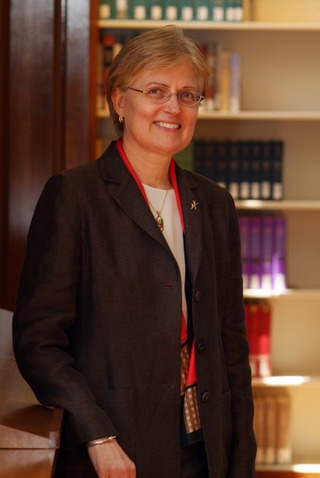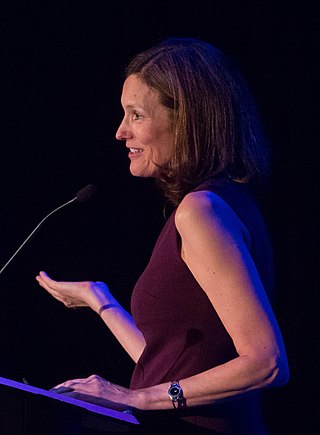Related Research Articles

Stuart Schreiber is an American chemist who is the Morris Loeb Research Professor at Harvard University,a co-founder of the Broad Institute,Howard Hughes Medical Institute Investigator,Emeritus,and a member of the National Academy of Sciences and National Academy of Medicine. He currently leads Arena BioWorks.
Tobin Jay Marks is an inorganic chemistry Professor,the Vladimir N. Ipatieff Professor of Catalytic Chemistry,Professor of Material Science and Engineering,Professor of Chemical and Biological Engineering,and Professor of Applied Physics at Northwestern University in Evanston,Illinois. Among the themes of his research are synthetic organo-f-element and early-transition metal organometallic chemistry,polymer chemistry,materials chemistry,homogeneous and heterogeneous catalysis,molecule-based photonic materials,superconductivity,metal-organic chemical vapor deposition,and biological aspects of transition metal chemistry.

Carolyn Ruth Bertozzi is an American chemist and Nobel laureate,known for her wide-ranging work spanning both chemistry and biology. She coined the term "bioorthogonal chemistry" for chemical reactions compatible with living systems. Her recent efforts include synthesis of chemical tools to study cell surface sugars called glycans and how they affect diseases such as cancer,inflammation,and viral infections like COVID-19. At Stanford University,she holds the Anne T. and Robert M. Bass Professorship in the School of Humanities and Sciences. Bertozzi is also an Investigator at the Howard Hughes Medical Institute (HHMI) and is the former director of the Molecular Foundry,a nanoscience research center at Lawrence Berkeley National Laboratory.

In genetics,crosslinking of DNA occurs when various exogenous or endogenous agents react with two nucleotides of DNA,forming a covalent linkage between them. This crosslink can occur within the same strand (intrastrand) or between opposite strands of double-stranded DNA (interstrand). These adducts interfere with cellular metabolism,such as DNA replication and transcription,triggering cell death. These crosslinks can,however,be repaired through excision or recombination pathways.

The Science History Institute is an institution that preserves and promotes understanding of the history of science. Located in Philadelphia,Pennsylvania,it includes a library,museum,archive,research center and conference center.

JoAnne Stubbe is an American chemist best known for her work on ribonucleotide reductases,for which she was awarded the National Medal of Science in 2009. In 2017,she retired as a Professor of Chemistry and Biology at the Massachusetts Institute of Technology.

Cynthia "Cyndie" Anne Maryanoff is an American organic and materials chemist. Among other awards,she received the 2015 Perkin Medal for outstanding work in applied chemistry in the U.S.A.
Derek Lowe is a medicinal chemist working on preclinical drug discovery in the pharmaceutical industry. Lowe has published a blog about this field,"In the Pipeline",since 2002 and is a columnist for the Royal Society of Chemistry's Chemistry World.

Elsa Reichmanis is an American chemist,who was the 2003 president of the American Chemical Society. She was elected a member of the National Academy of Engineering in 1995 for the discovery,development,and engineering leadership of new families of lithographic materials and processes that enable VLSI manufacturing. She was also inducted into the National Academy of Inventors in 2020. She is currently the Anderson Endowed Chair in Chemical and Biomolecular Engineering at Lehigh University. She previously served on the faculty at The Georgia Institute of Technology. Reichmanis is noted for her research into microlithography,and is credited for contributing to the "development of a fundamental molecular level understanding of how chemical structure affects materials function leading to new families of lithographic materials and processes that may enable advanced VLSI manufacturing".

Hai-Lung Dai is a Taiwanese-born American physical chemist and university administrator. He currently is the Laura H. Carnell Professor of Chemistry and Vice President for International Affairs at Temple University in Philadelphia,Pennsylvania,in the United States.
Peter Wipf is a distinguished university professor of chemistry at the University of Pittsburgh. His research interests focus on the total synthesis of natural products,the discovery of new transformations of strained molecules,and the development of new pharmaceuticals. He is a Fellow of the Royal Society of Chemistry (RSC),the American Association for the Advancement of Science (AAAS),and the American Chemical Society (ACS).

Ann E. Weber is the senior vice president for drug discovery at Kallyope Inc. in New York City. She previously worked with Merck Research Laboratories (MRL),joining the company in 1987 and retiring from the position of vice president for lead optimization chemistry in 2015. She has helped develop more than 40 drug candidates including FDA-approved treatments for Type 2 diabetes. She has received a number of awards,including the Perkin Medal (2017) and has been inducted into the ACS Division of Medicinal Chemistry’s MEDI Hall of Fame.

Nancy A. Thornberry is the founding CEO and current chair,R&D at Kallyope Inc. in New York City. She previously worked with Merck Research Laboratories (MRL),joining the company in 1979 as a biochemist and retiring from the position of senior vice president and franchise head,diabetes and endocrinology in 2013.
Kenneth M. Merz Jr. is an American biochemist and molecular biologist currently the Joseph Zichis Chair and a distinguished university professor at Michigan State University and editor-in-chief of American Chemical Society's Journal of Chemical Information and Modeling. A highly cited expert in his field,his research interests are in computational chemistry and biology and computer-aided drug design (CADD). His group has been involved in developing the widely using AMBER suite of programs for simulating chemical and biological systems and the QUICK program for quantum chemical calculations.
Kelly Chibale PhD,MASSAf,FAAS,Fellow of UCT,FRSSAf,FRSC is professor of organic chemistry at the University of Cape Town,and the founder and director of H3D research center and H3D Foundation NPC. In 2018 he was recognised as one of Fortune magazine's top 50 World's Greatest Leaders. His research focuses on drug discovery and the development of tools and models to contribute to improving treatment outcomes in people of African descent or heritage.
Alexandros Makriyannis is an American biochemist and professor of chemistry and chemical biology in the department of medicinal chemistry at Northeastern University in Boston,Massachusetts,where he directs the Center for Drug Discovery and holds the George Behrakis Chair of Pharmaceutical Biotechnology. His research has focused on the biochemical basis of the endocannabinoid system and on the development of synthetic cannabinoids.
Kay Michille Brummond is an American synthetic chemist who is Professor of Chemistry and Associate Dean of Faculty at the University of Pittsburgh. Her interests consider cycloaddition reactions that can realise molecules and natural products for organic photovoltaics and targeted covalent inhibitors. She was elected a Fellow of the American Chemical Society (ACS) in 2010,a Fellow of the AAAS in 2021,and awarded the ACS National Award for Encouraging Women into Careers in the Chemical Sciences in 2021.

Julia Laskin is the William F. and Patty J. Miller Professor of Analytical Chemistry at Purdue University. Her research is focused on the fundamental understanding of ion-surface collisions,understanding of phenomena underlying chemical analysis of large molecules in complex heterogeneous environments,and the development of new instrumentation and methods in preparative and imaging mass spectrometry.
Christine D. Keating is an American scientist who is the Shapiro Professor of Chemistry at Pennsylvania State University. Her research involves colloid and interface chemistry for biology and materials science.
References
- 1 2 3 4 5 6 American Men & Women of Science, 1995-96: A Biographical Directory of Today's Leaders in Physical, Biological and Related Sciences. Vol. 3 (19th ed.). New Providence, New Jersey: R. R. Bowker. 1996. pp. 739–740. ISBN 978-0835234665.
- 1 2 3 4 5 6 7 8 9 "Transitioning into a renewed focus on excellence" (PDF). MUDD in your eye. No. Fall. Lehigh University, Department of Chemistry. 2018. pp. 4–5, 18. Archived from the original (PDF) on 6 October 2018. Retrieved 5 October 2018.
- ↑ Finn, John (1 October 2015). "Helen Murray Free Lectures Feature Pharmaceutical Expert". Wooster. Archived from the original on 4 December 2017. Retrieved 10 October 2017.
- 1 2 "Ned Heindel Ph.D." Bloomberg. Retrieved 10 October 2017.
- 1 2 Carpenter, Ernest (23 November 1992). "Ned Heindel chosen ACS president-elect". Chemical & Engineering News. 70 (47): 5–6. doi:10.1021/cen-v070n047.p005a.
- 1 2 3 "Biography: Ned Heindel". Lehigh University. Retrieved 10 October 2017.
- ↑ "Obituary". 6 July 2023.
- 1 2 "Awarded Chemistry Recognition Dr. Ned D. Heindel Red Lion". York Daily Record from York, Pennsylvania. June 2, 1976. p. 6. Retrieved 10 October 2017.
- ↑ Kaufman, Ron (January 11, 1993). "People: Lehigh Professor Is Named Chemical Society's President-Elect". The Scientist. Retrieved 10 October 2017.
- 1 2 3 Committee on Promoting Safe and Secure Chemical Management in Developing Countries, Board on Chemical Sciences and Technology, Division on Earth and Life Studies, National Research Council of the National Academies (2010). Promoting chemical laboratory safety and security in developing countries. Washington, D.C.: National Academies Press. p. 75. ISBN 978-0309150415 . Retrieved 10 October 2017.
{{cite book}}: CS1 maint: multiple names: authors list (link) - 1 2 3 Henderson, Andrea Kovacs, ed. (2010). "Heindel, Ned Duane". American Men & Women of Science: A Biographical Directory of Today's Leaders in Physical, Biological, and Related Sciences. Vol. 3 (28th ed.). Detroit: Gale. p. 701. Retrieved 11 June 2018.
- ↑ "Newsletter of the Lehigh Valley Section" (PDF). American Chemical Society, Lehigh Valley Section. October 2018. p. 2. Archived from the original (PDF) on 6 October 2018. Retrieved 5 October 2018.
- ↑ Heindel, Ned D., ed. (1978). The Chemistry of radiopharmaceuticals. New York: Masson Pub. USA. ISBN 978-0893520199.
- ↑ Welch, Michael J. (September 24, 2013). Radiopharmaceuticals and Other Compounds Labelled with Short-Lived Radionuclides. Elsevier. p. 77. ISBN 978-1483104164 . Retrieved 12 June 2018.
- ↑ "Ned D. Heindel, Ph.D." UMDNJ-Rutgers University CounterACT Research Center of Excellence. Archived from the original on 15 May 2015. Retrieved 10 October 2017.
- ↑ "Patents by Inventor Ned D. Heindel". Justia Patents. Retrieved 10 October 2017.
- ↑ "Ned D. Heindel". Lehigh University. Retrieved 10 October 2017.
- ↑ Salter, Rosa (August 28, 1995). "Lehigh Professor's Patent Pays Off For Blood Sterilization". The Morning Call. Retrieved 11 June 2018.
- 1 2 Joseph, Laurie B.; Composto, Gabriella M.; Perez, Roberto M.; Kim, Hong-Duck; Casillas, Robert P.; Heindel, Ned D.; Young, Sherri C.; Lacey, Carl J.; Saxena, Jaya; Guillon, Christophe D.; Croutch, Claire R.; Laskin, Jeffrey D.; Heck, Diane E. (September 2018). "Sulfur mustard induced mast cell degranulation in mouse skin is inhibited by a novel anti-inflammatory and anticholinergic bifunctional prodrug". Toxicology Letters. 293: 77–81. doi:10.1016/j.toxlet.2017.11.005. PMC 5938161 . PMID 29127031.
- ↑ Bourke, Frederic A. Jr. "US20140341845A1: Methods and systems for treating cell proliferation related disorders". US Patents. Retrieved 11 June 2018.
U.S. Pat. No. 5,216,176 of Heindel discloses a large number of psoralens and coumarins that have some effectiveness as photoactivated inhibitors of epidermal growth factor. Halogens and amines are included among the vast functionalities that could be included in the psoralen/coumarin backbone.
- ↑ Acton, Q. Ashton (June 21, 2013). Advances in DNA Research and Application (2013 ed.). Atlanta, Georgia: Scholarly Editions. p. 169. ISBN 978-1481682350 . Retrieved 11 June 2018.
- ↑ Heindel, Ned D.; Choudhuri, Mridula; Ressner, Joel; Foster, Natalie (January 1985). "Aminomethyl psoralens. Electrophilic substitution of hydroxymethylphthalimide on linear furocoumarins". Journal of Heterocyclic Chemistry. 22 (1): 73–76. doi:10.1002/jhet.5570220119.
- ↑ Heindel, Ned D.; Van Dongen, Jacobus M.A.M.; Sachais, Bruce S.; Phillips, John H.; Gallo, Michael A.; Laskin, Jeffrey D. (July 1991). "Syntheses of Psoralen Analogues and Evaluation of Their Inhibition of Epidermal Growth Factor Binding". Journal of Pharmaceutical Sciences. 80 (7): 686–689. doi:10.1002/jps.2600800715. PMID 1941569 . Retrieved 11 June 2018.
- ↑ Laskin, Jeffrey D.; Jan, Yi-Hua; Jetter, Michele M.; Guillon, Christophe D.; Mariano, Thomas M.; Heck, Diane E.; Heindel, Ned D. (May 2018). "Identification of a Pyranocoumarin Photosensitizer that is a Potent Inhibitor of Keratinocyte Growth". Photochemistry and Photobiology. 94 (3): 577–582. doi:10.1111/php.12882. PMID 29315592. S2CID 3634344.
- ↑ Lally, Robin (December 1, 2016). "Rutgers Receives $19 Million to Develop Drugs to Treat Chemical Weapons Attacks Work aimed at devising drug therapies to counteract deadly chemical poisons". Rutgers Today. Retrieved 10 October 2017.
- ↑ Lacey, Carl J.; Wohlman, Irene; Guillon, Christophe; Saxena, Jaya; Fianu-Velgus, Cynthia; Aponte, Erik; Young, Sherri C.; Heck, Diane E.; Joseph, Laurie B.; Laskin, Jeffrey D.; Heindel, Ned D. (August 2016). "Multi-inhibitor prodrug constructs for simultaneous delivery of anti-inflammatory agents to mustard-induced skin injury". Annals of the New York Academy of Sciences. 1378 (1): 174–179. Bibcode:2016NYASA1378..174L. doi:10.1111/nyas.13177. PMC 5063683 . PMID 27505078.
- ↑ Gordon, Marion; Rodrigues, Andrea; Hahn, Rita; Gerecke, Donald; Svoboda, Kathy; Heindel, Ned (June 2013). "Corneal Wound Healing is Facilitated by Hydroxamates that Reduce EMMPRIN Expression". Investigative Ophthalmology & Visual Science. 54: 3910. Retrieved 12 June 2018.
- 1 2 3 "Board of Directors". Pennsylvania Drug Discovery Institute. Retrieved 10 October 2017.
- ↑ "ACS Presidents, A Chronological List". American Chemical Society. Retrieved 10 October 2017.
- ↑ Wilson, Elizabeth (8 February 1999). "Luminaries highlight chemistry's contributions". Chemical & Engineering News. 77 (6): 38. doi:10.1021/cen-v077n006.p038a.
- 1 2 "ACS Fellows" . Retrieved 10 October 2017.
- ↑ Achilladelis, Basil; Bowden, Mary Ellen (1989). Structures of Life: To Accompany an Exhibit by the Beckman Center for the History of Chemistry. Philadelphia, Pa.: Beckman Center for the History of Chemistry. p. 37. ISBN 978-0-941901-07-9 . Retrieved 10 October 2017.
- 1 2 "The History of CHF". Chemical Heritage: Newsmagazine of the Chemical Heritage Foundation. 18 (1): 16–22. 2000-02-01.
- ↑ Heindel, Ned (2000). "The story behind the story". Chemical Heritage Magazine. 18 (3). Chemical Heritage Foundation: 45.
- ↑ Wotiz, John H. (2000). "History of Chemistry: The ACS Centre in Philadelphia". Chemical Heritage. 18 (3): 45–46.
- ↑ Heindel, Ned D.; Sturchio, Jeffrey L.; Bohning, James J. (2018). "Chapter 14: The Professionalization of American Chemistry: How the German Ph.D. Model Crossed the Atlantic". In Rasmussen, Seth C. (ed.). Igniting the Chemical Ring of Fire. New Jersey: World Scientific. pp. 387–426. doi:10.1142/9781786344557_0014. ISBN 978-1-78634-454-0.
- ↑ Heindel, Ned D.; Pfau, Michel A. (July 1965). "A profitable partnership: Giacomo Ciamician and Paul Silber". Journal of Chemical Education. 42 (7): 383. Bibcode:1965JChEd..42..383H. doi:10.1021/ed042p383.
- ↑ "The Nineteenth Century Horse Doctor: A Pennsylvania Dutchman's Practical Guide to Treating Horses". Coffeetown Press. 8 August 2011. Retrieved 11 June 2018.
- ↑ Heindel, Ned D.; Rapp, Robert D. (2011). The Nineteenth-century horse doctor : a Pennsylvania Dutchman's practical guide for treating horses. Seattle, WA: Coffeetown Press. ISBN 9781603811217.
- ↑ White, Thomas (2013). Witches of Pennsylvania : occult history & lore. Arcadia Publishing. ISBN 978-1626191327.
- ↑ Bentley, Tiffany (Oct 29, 2011). "Witchcraft in Williams Township, a history of the good and evil". Lehigh Valley Live. Retrieved 11 June 2018.
- ↑ Merlin, Michelle (October 30, 2016). "Haunted rock legends live on in technology, religion". AP. Retrieved 11 June 2018.
- ↑ Heindel, Ned D. (2009). Hexenkopf: History, Healing and Hexerei (2nd ed.). Northampton County Historical and Genealogical Society. ISBN 978-1877701177.
- ↑ "On the Shelf: Hexenkopf: History, Healing and Hexerei". Papers Falling from an Attic Window. 2006-08-06. Retrieved 11 June 2018.
- ↑ "Contributors". Pennsylvania Folklife Magazine. 41 (3). 1992. Retrieved 10 October 2017.
- ↑ "Pennsylvania Folklife Magazine". Digital Commons at Ursinus. Retrieved 10 October 2017.
- ↑ Sigafoos, Lewis (1935). "Buckwampum Historical and Literary Society". In Fackenthal, B.F. (ed.). Bucks County Historical Society Papers. Vol. 7. Bucks Country Historical Society. pp. 414–419.
- ↑ Clark, Kathryn Finegan (2018). "Once upon a time in Durham". Bucks County Herald. Archived from the original on 16 July 2018. Retrieved 16 July 2018.
- 1 2 3 Kraus, Scott; Palochko, Jacqueline (October 14, 2014). "Proposed 105-mile PennEast pipeline rattles residents". The Morning Call. Retrieved 21 February 2018.
- ↑ "Land Preservation Board". Williams Township, Northampton County, PA. Retrieved 21 February 2018.
- ↑ Hurdle, Jon (February 8, 2018). "PennEast pipeline seeks eminent domain, plus U.S. marshals to protect workers". StateImpact. NPR. Retrieved 21 February 2018.
- ↑ Hurdle, Jon (February 15, 2018). "Pipeline Conflict Heats Up: Landowners Vow to Fight PennEast on Eminent Domain". NJ Spotlight. Retrieved 21 February 2018.
- ↑ Hurdle, Jon (February 19, 2018). "Landowners brace for eminent domain loss in PennEast pipeline cases". StateImpact. NPR. Retrieved 21 February 2018.
- 1 2 Wright, Emma (February 20, 2018). "Residents fight for their land against PennEast pipeline". 69 News. Retrieved 21 February 2018.
- ↑ Palochko, Jacqueline (November 9, 2014). "Newsmaker Q&A: Linda Heindel, PennEast Pipeline opponent". The Morning Call. Retrieved 21 February 2018.
- ↑ "Hillman Faculty Award". University Awards. Lehigh University. Retrieved 10 October 2017.
- ↑ Berg, Christian (May 17, 2002). "Ben Franklin Technology center honors eight leaders for contribution to economy". The Morning Call.
- ↑ "Dr. Henry A. Hill Distinguished Lecture". National Organization for the Professional Advancement of Black Chemists and Chemical Engineers. Retrieved 10 October 2017.
- ↑ "Section Awards and Grants". American Chemical Society. Retrieved 10 October 2017.